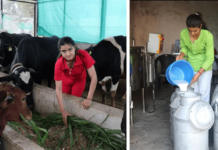Kolkata, June 13, 2020: Revenue growth of India’s dairy industry will see a flat revenue growth this year after a decade of strong growth because of weak sales of value-added products like ice cream, cheese, flavoured milk and yoghurt, particularly during the lockdown, according to a Crisil NSE -1.53 % report.
The industry had logged a 10% compound annual growth rate in the past decade, it said.
Sales of value-added products account for over a third of the organised dairy sector’s revenue, are expected to contract 2%-3% this fiscal. That would reduce operating profitability by as much as 50-75 basis points (bps), it said.
Further, a build-up of inventory – on account of surplus milk being converted to skimmed milk powder (SMP) and unsold value added product inventory will increase the working capital needs of dairies and test the liquidity of mid-sized ones (revenue below Rs 500 crore).
The report is based on analysis of 65 CRISIL-rated dairies that account for slightly more than two-thirds of the Rs 1.5 lakh crore revenue of the organised dairy segment, and assumes a return to normalcy in the second quarter.
The two-month-long closure of hotels and restaurants because of the nationwide lockdown halted institutional value added product sales, which account for almost 20% of the organised dairy segment’s revenue. Moreover, logistical challenges and apprehensions about consuming cold products (ice creams, flavoured milk and yoghurt) during the pandemic is impacting sales in the first quarter, which is the peak-demand season.
However, steady liquid milk sales, comprising two-thirds of total industry sales, will prevent a bigger fall in revenue. The lockdown has not affected the supply of milk since it is an essential product. Overall, therefore, milk sales should rise 3-4% this fiscal.
“Steady demand for milk and higher value added product prices (hiked 10% in the second half of last fiscal) will help partially offset lower VAP volume, and arrest any decline in the dairy sector’s revenue,” said Sameer Charania, Director, CRISIL Ratings, .
The flush season (typically from October to March), which sees higher production, got extended by a couple of months leading to oversupply of milk in April and May. Consequently, dairies, especially cooperatives that are better off in terms of liquidity and working capital, have converted such excess milk into SMP. Year-end inventory could rise 14% after dropping sharply in March 2020, resulting in higher working capital needs according to the reports published in economictimes.indiatimes.com.
Rahul Guha, director, Crisil Ratings said: “While dairies reduce capital spending, tapered cash flows stemming from lower sales and higher working capital requirement will jack up short-term borrowings by 20% this fiscal. While large dairies have better liquidity, mid-sized ones would feel the squeeze.”
Given higher debt and lower operating profitability, the average interest coverage ratio of the 65 Crisil-rated dairies will touch a five-year low of 4 times this fiscal.

































